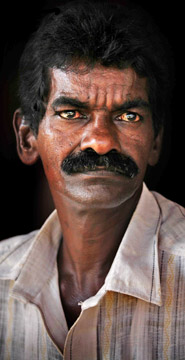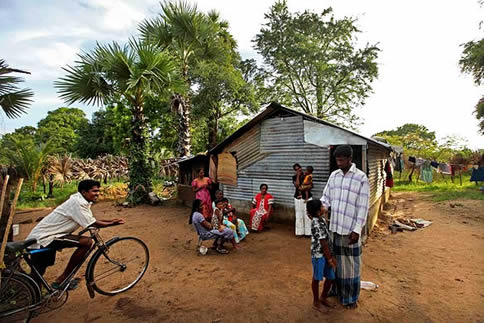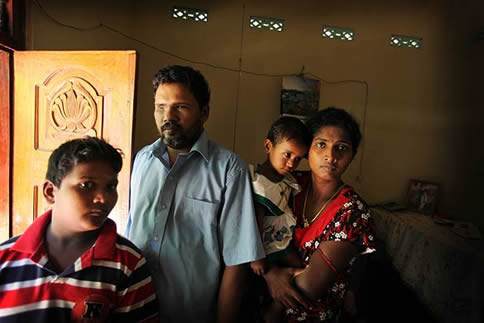
Ilankai Tamil Sangam
Association of Tamils of Sri Lanka in the USA
Published by Sangam.org
by Anthony Lloyd, The Times, London, December 5, 2009
|
However, the definition of “Tamil Tiger” is unclear. Apart from the hardcore Tiger cadres, many of those in the camps are thought to be youths forcibly conscripted by the Tigers during the final stages of their collapse, as well as their family members and civil administrators... “As for ‘secret’ detention camps? I wouldn’t openly say that they exist for sure, but I tend to think they do. Some men have been taken away and never accounted for.” |
Trincomalee -- Sri Lanka is holding more than 11,000 Tamil prisoners without charge in closely guarded “rehabilitation centres”, despite the Government’s claim that it released all Tamil civilians from detention centres this week.
 |
| S. Sivalingam, who was displaced with his family from their home in the Vanni area. They were released from an internally displaced persons (IDP) camp on December 1, and made their way to Trincomalee, on the eastern coast, where they have friends |
The Times can reveal that the group of prisoners, whose exact number has been unknown since the Sri Lankan Government blocked access to them from the International Committee of the Red Cross (ICRC) in July, is allegedly a “combatant category” that includes former Tamil Tiger (LTTE) fighters.
However, the definition of “Tamil Tiger” is unclear. Apart from the hardcore Tiger cadres, many of those in the camps are thought to be youths forcibly conscripted by the Tigers during the final stages of their collapse, as well as their family members and civil administrators.
According to media reports, the parents of Velupillai Prabhakaran, the Tamil Tiger leader killed this year, are being held in the notorious “4th Floor” detention complex in Colombo. They are in their seventies and had long been alienated from their son by his terrorist activities.
About 300,000 Tamil civilians were caught up in fighting earlier this year as the Sri Lankan military made its final push against the Tigers which used civilians as human shields. About 280,000 civilians were captured by the army and kept in detention centres. The last 130,000 prisoners were set free this week. But there is now concern over the fate of the 11,000 still being held.
Detention without trial is familiar to many Sri Lankan prisoners, who can be incarcerated for the most trivial of reasons under the Government’s wideranging emergency powers and Prevention of Terrorism Act.
“Until July the ICRC had access to the 12 ‘rehabilitation’ camps in the Vavuniya area,” a former ICRC staff member said this week. “There are fewer of these camps now as some have amalgamated. Under-age LTTE fighters, as well as most of those who surrendered, are sent to these camps while senior LTTE cadres are held in CID custody then sent directly to Boosa Prison near Galle. The ICRC registered all of these prisoners, after which they informed their families of their whereabouts. But since the ICRC access was stopped it has left a big gap which still hasn’t been replaced.”
 |
The Muvaga Swaran family at their temporary home near Trincomalee. They were displaced from the Vanni area following the final battle between the LTTE (Tamil Tigers) and the Sri Lankan military. They were in the Manik Farm IDP camp in Vanni for five months before being released a few weeks ago |
Recent reports suggest that the country’s authorities have authorised a new round of arrests over the past few weeks among civilians on the point of release.
Father V. Yogeswaran, director of the Centre for the Promotion and Protection of Human Rights, in Trincomalee, said: “I’ve got between 30 and 40 cases in which families have been released here from the detention centres, only to have their menfolk taken away at the final moment to a so-called rehabilitation centre.
“As for ‘secret’ detention camps? I wouldn’t openly say that they exist for sure, but I tend to think they do. Some men have been taken away and never accounted for.”
 |
| Kanthay Visavalingam (centre) with his family. They are displaced from their home in the Vanni and are staying with friends near Trincomalee. He was blinded by Sri Lankan army artillery shrapnel in the last days of fighing between the Army and the LTTE in the Vanni area |
Some of the Government’s suspicions concerning the presence of Tiger fighters inside the civilian camps are legitimate. The Times encountered two teenage Tigers, released from civilian camps in October, who had disguised their identity. Having abandoned their uniforms and weapons during the final fighting in May, snapped the cyanide capsules from their necks and threw them to the ground, they had then joined the desperate crowds of civilians running through the gunfire.
“I grabbed the hands of the nearest family I saw,” one, calling himself Sayoo, said. “When we finally came to the first group of soldiers they assumed I was part of that family.”
Throughout four interrogation sessions both men claimed to be students. Eventually they were left alone among the detained civilians, one in a Zone 6 camp, the other in Zone 2.
“From time to time in Zone 6 I would see one of my LTTE comrades who had also got away,” Sayoo said. “We would never speak to one another, just give one another a look and then walk on. There were other people, civilians, who knew who we were, but no one said anything.”
Not all of them were so lucky. One who came back from a Zone 2 camp described Tiger recruiting officials, who had forcibly enlisted young cadres, being beaten up by outraged mothers whose missing sons they had pushed into service.
© 1996-2025 Ilankai Tamil Sangam, USA, Inc.